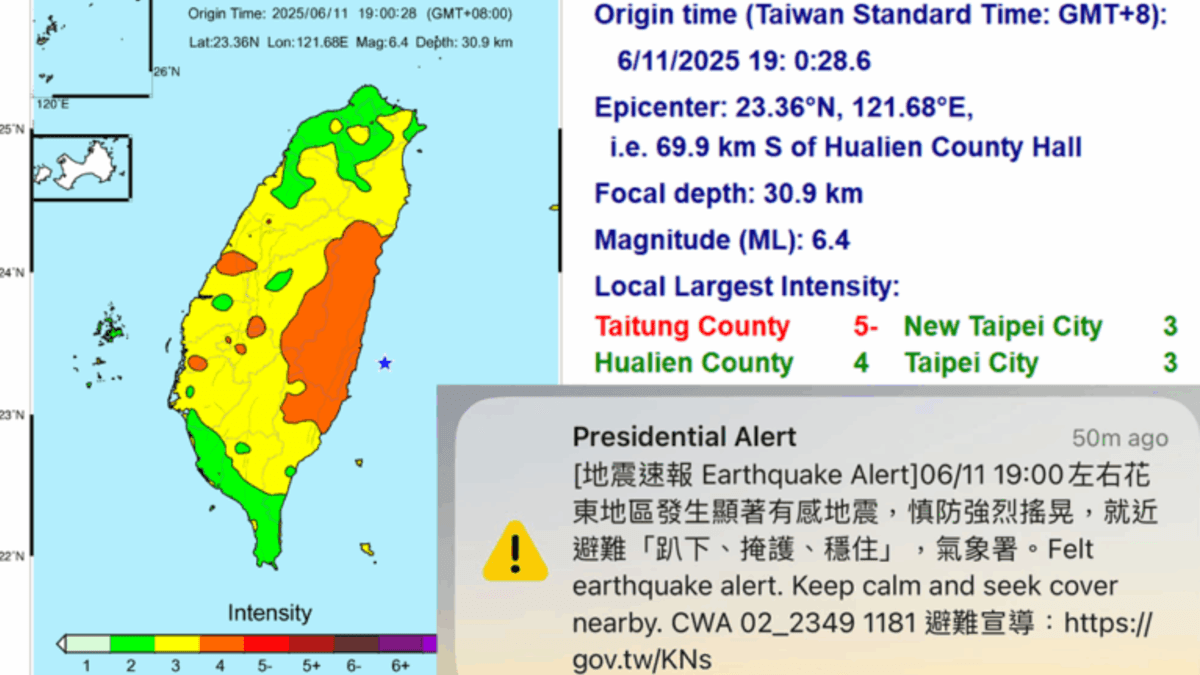Earthquake of magnitude 6.4 strikes off Taiwan’s east coast, no major damage reported
A magnitude 6.4 earthquake struck off Taiwan’s east coast on 11 June 2025, triggering emergency alerts. Authorities reported no major damage or casualties, though transport systems briefly slowed operations as precautionary checks were carried out.

- A magnitude 6.4 earthquake struck off Taiwan’s east coast on 11 June 2025, centred south of Hualien County at a depth of 30.9 kilometres.
- No major damage or casualties were reported, though transport systems temporarily slowed for precautionary checks.
- Authorities emphasised continued vigilance, with aftershocks possible and inspections of infrastructure ongoing.
A magnitude 6.4 earthquake struck off the east coast of Taiwan on 11 June 2025, prompting nationwide alerts but causing no major damage or casualties, according to the Central Weather Administration (CWA).
The tremor occurred at 7 p.m. local time. Its epicentre was located 69.9 kilometres south of Hualien County Hall, under the Pacific Ocean, with a focal depth of 30.9 kilometres.
The CWA reported the strongest ground shaking at a low level 5 on Taiwan’s seven-tier intensity scale in Taitung County. Other counties, including Hualien, Nantou, Taichung, Changhua, Yunlin, and Chiayi, recorded level 4 intensities.
Emergency alerts and response
The earthquake triggered Taiwan’s national emergency alert system, which broadcast warnings through mobile devices, television, and radio. Emergency agencies were placed on high alert as a precaution against possible aftershocks.
Transport authorities immediately introduced safety checks. In the Taipei metropolitan area, mass rapid transit (MRT) systems slowed train speeds before resuming normal services once inspections confirmed no damage.
The Taiwan High-Speed Rail (THSR), which connects Taipei in the north to Kaohsiung in the south, was unaffected. Services continued according to schedule, easing concerns over large-scale disruption to passenger movement.
The Ministry of Economic Affairs confirmed there were no widespread power outages. Communication services and water supply systems also operated without disruption.
Scale and impact
Taiwan’s seismic intensity scale, which ranges from 1 to 7, is distinct from the magnitude scale. It measures the strength of shaking felt at specific locations. A level 5 tremor is categorised as moderate to strong, with the potential to cause unsecured objects to shift or fall indoors.
Level 4 shaking, as recorded in several central and western counties, is typically felt indoors by many and may rattle windows and doors but rarely leads to structural damage.
The absence of significant destruction reflected both the depth of the earthquake and Taiwan’s stringent building codes. Following devastating quakes in past decades, authorities implemented reinforced construction standards, particularly for high-rise structures in Taipei and other urban centres.
Historical context
Taiwan is one of the most seismically active regions in the world, situated along the boundary of the Philippine Sea Plate and the Eurasian Plate. Earthquakes occur frequently, and preparedness is a central feature of national safety planning.
The island experienced one of its deadliest quakes in 1999, when a magnitude 7.6 event in Nantou killed more than 2,400 people and injured tens of thousands. More recently, in April 2024, a magnitude 7.4 earthquake struck near Hualien, resulting in at least 18 deaths and widespread landslides along the eastern coast.
The 11 June 2025 event, while powerful, caused far less disruption. Analysts attributed this to its offshore epicentre and moderate depth, factors that reduced the shaking intensity in densely populated regions.
Preparedness and public safety
Taiwan’s Central Weather Administration has invested heavily in early warning systems that can deliver alerts seconds before tremors are felt. On this occasion, the alert allowed citizens and institutions to take immediate precautions.
Schools and workplaces reported implementing standard earthquake drills, with staff and students instructed to take cover under desks or move to safe areas away from windows.
Hospitals activated emergency protocols, preparing additional capacity in case of casualties. By late evening, however, no serious injuries or fatalities had been reported.
Reactions and next steps
Authorities urged the public to remain cautious, noting the potential for aftershocks. “Even when the initial impact seems limited, we must continue monitoring in the hours and days ahead,” a CWA spokesperson stated.
The National Fire Agency confirmed rescue units remained on standby in case of localised incidents. Teams were deployed to conduct rapid inspections of bridges, tunnels, and coastal highways in eastern Taiwan.
While no structural failures were reported, engineers were tasked with verifying the stability of critical infrastructure. The inspection process is expected to continue into the coming days.
Broader regional implications
The earthquake was felt beyond Taiwan, with some reports of mild shaking in parts of the Ryukyu Islands, Japan. Japanese authorities confirmed there was no tsunami threat.
The Pacific Tsunami Warning Center, based in Hawaii, also assessed the event and determined that the earthquake’s depth and location posed no risk of tsunami generation.
Taiwan’s strong resilience to seismic events has been highlighted in regional discussions about disaster preparedness. Neighbouring countries in the Asia-Pacific zone frequently study Taiwan’s building standards and rapid alert systems as models for enhancing their own disaster response frameworks.
Looking ahead
Experts emphasised that the 11 June tremor serves as a reminder of Taiwan’s continuing vulnerability to seismic activity. While damage was avoided on this occasion, the island remains at risk of future high-magnitude earthquakes.
Local governments plan to conduct further community drills in the coming weeks to reinforce public readiness. Engineering agencies will also review lessons from the event to identify potential improvements in infrastructure resilience.
The Central Weather Administration reiterated that residents should remain prepared with emergency supplies, including food, water, and first-aid kits, as part of household safety planning.








0 Comments